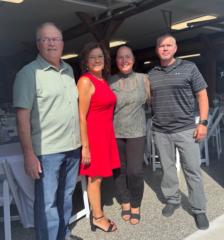6d • Article Series
The 30-Day Brain Upgrade (Part 2): Stress-Proofing the Mind
By the time you finish the first two weeks of the program, you’ll notice clearer thinking and sharper focus. But clarity alone is not enough. The real test of the brain comes under stress. Week three of the program is designed to build resilience and antifragility teaching your mind to grow stronger, not weaker, in the face of challenge.
Stress is not the enemy. When used correctly, it is the raw material for growth. Just as a muscle adapts when loaded with weight, your brain adapts when given the right dose of uncertainty, pressure, and disorder. The key is to expose yourself to stressors in controlled amounts and pair them with recovery practices. That’s exactly what this part of the program delivers.
The daily thinking routine in week three is the systems lens. Instead of seeing problems in isolation, you draw out loops, feedbacks, and consequences. Mapping a system forces your mind to move beyond linear cause-and-effect and into the world of complexity. You begin to see how one choice cascades into many outcomes.
The reading for this week is Nassim Taleb’s Antifragile. Taleb makes the case that some systems, including the human brain, don’t just withstand stress they require it to grow. Ideas like optionality, volatility, and skin in the game challenge you to see risk differently. Instead of trying to eliminate all uncertainty, you learn to create buffers and set conditions so disorder benefits you.
Memory practice evolves into sketching from memory. After reading or reflecting, take a blank page and try to reconstruct the key ideas visually. You might draw loops, arrows, or quick diagrams. This forces a deeper encoding because the brain works harder when translating words into images.
The journaling prompts are designed to confront stress head-on. Ask yourself: “What stressors do I avoid that could make me stronger?” and “How could I benefit from disorder?” These questions open the door to uncomfortable but useful insights. You might find that avoiding difficult conversations or tough projects is holding you back. By leaning into them, you start to reshape your relationship with stress.
Rest practices in week three include hormetic stressors. Cold showers, breath control, or even brief fasts push your body and mind into short bouts of discomfort. The goal is not punishment but adaptation. Pair these with calming recovery sessions and you begin to condition resilience.
On day twenty, you do a 24-hour experiment: break a familiar routine and see what surfaces. It could be something as small as commuting a different way, working in silence, or leaving your phone off until noon. Journal the effects. Disrupting habits shakes loose automatic thinking and forces new awareness.
On day twenty-one, the integration practice is to write a short essay: “Where in life am I antifragile?” This reflection cements the lessons of the week. You begin to see where stress makes you weaker and where it makes you stronger.
By the end of week three, you’ll notice a shift. Situations that once felt overwhelming now feel like training opportunities. The goal is not to avoid disorder but to build the confidence that your brain can absorb shocks, adapt, and even thrive because of them.
Part 3 of the series will take you into the final phase: synthesis and creativity. You’ll pull together the routines, the reading, and the reflections into a personal Brain OS a simple operating system for thinking that you can use long after the 30 days are over.
Daily Flow (30–60 minutes total)
• Thinking Routine (10–15 min)
• Prompt Journaling (10 min)
• Reading (15–20 min)
• Memory Practice (5–10 min)
• Rest Practice (10–15 min)
Week 3: Resilience & Antifragility
Day 15
• Thinking: Map a system you deal with daily (work process, health habit, relationship).
• Prompt: “What stressors do I avoid that could make me stronger?”
• Reading: Antifragile Part I.
• Memory: Sketch yesterday’s concepts from memory.
• Rest: 2–3 min cold shower, followed by box breathing.
Day 16
• Thinking: Draw a feedback loop for one decision you made recently.
• Prompt: “Where in my life could volatility actually benefit me?”
• Reading: Antifragile Part II (randomness and optionality).
• Memory: Recall and sketch key points without notes.
• Rest: 10–15 min NSDR.
Day 17
• Thinking: Identify hidden fragility in your routine (e.g., over-reliance on one habit or tool).
• Prompt: “What buffers or redundancies can I create to handle uncertainty better?”
• Reading: Antifragile Part II continued.
• Memory: Sketch concepts into a flowchart.
• Rest: 2–3 min breath holds or controlled hyperventilation.
Day 18
• Thinking: Map a chain reaction (if this happens → then what?).
• Prompt: “Where do I confuse stability with fragility?”
• Reading: Antifragile Part III.
• Memory: Re-sketch the key argument in your own words.
• Rest: 20-min walk outside, no phone.
Day 19
• Thinking: Diagram how one small input could trigger a large change.
• Prompt: “How could I benefit from disorder?”
• Reading: Antifragile Part III continued.
• Memory: Draw yesterday’s reading as a story or metaphor.
• Rest: Cold shower + slow breathing before bed.
Day 20 (Experiment)
• Break a routine for 24 hours (change environment, habits, or input diet).
• Journal: “What did this disruption reveal?”
Day 21 (Integration)
• Write a 1-page essay titled: “Where in life am I antifragile?”
• Take a longer rest period—4-hour digital fast or nature immersion.
5
1 comment

skool.com/castore-built-to-adapt-7414
Where science meets results. Learn peptides, training, recovery & more. No ego, no fluff—just smarter bodies, better minds, built to adapt.
Powered by





